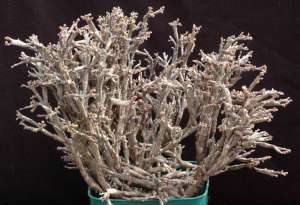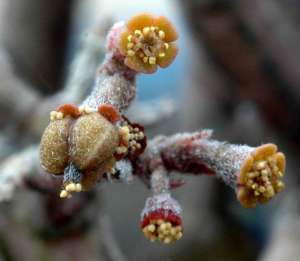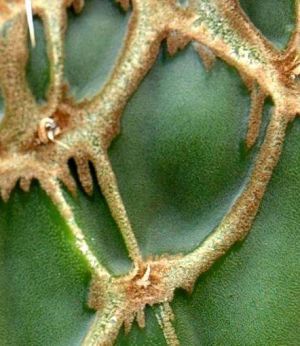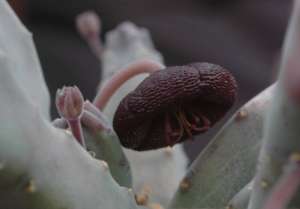|
Three
weirdoes from the show Trev
Wray |
|

Jeff's
Euphorbia platyclada in a 3½" pot.
(You can click the images in this article for a better view... just
should you want one!) |
The title applies to some plants,
not any people I hasten to add!
I was on the prowl for photos for
the mag and thought that the assembled Euphorbias at the Show were most
interesting. I sought Jeff’s permission to move his plant of Euphorbia
platyclada to a sunnier place for a decent digipic.
‘Despite what’s been said, it
is alive and it’s got flowers on it,’ said Jeff.
Yes, I could see what Jeff meant;
it did look rather dead. Platyclada is a distinctly different Euphorbia which
reminds me of dried seaweed, though it is not slimy of course. As to its demise,
through my macro lens I could see that the plant was covered in flowers and
new growth and was actually in very good health. The problem is that the flowers
are minute – just 2mm across and surely among the smallest in a genus famous
for the smallness of its flowers. |
|
Some do have brightly
coloured bracts, (the poinsettia springs straight to mind) but platyclada
lacks these as well. I resolved to take a close up of the flowers so that
readers of NN could enjoy the spectacle. I was quite pleased with the
result except that when I looked at the pictures on my computer a cobweb
was slung between two of the flowers which looked like a hawser. In best
artistic tradition I (digitally) painted it out!
Euphorbia platyclada
deserves more recognition on the show bench. It is slow growing and coming
from Madagascar needs a little more warmth than the common Cape species. I
killed a plant in a year, (rather a winter). Jeff’s plant would score
highly for maturity, condition, difficulty and rarity. Unfortunately it is
just so ugly and the flowers so small that I can never see it doing well
on the show bench. Maybe that accounts for the rarity! This actual plant
is ISI 971 which was originally propagated from the type collection of
Rauh. The ISI people write ‘This oddity should be in every collection’,
which says something about the ISI.
|

It must be alive - it has
flowers! - close-up
of the flowers on Jeff’s Euphorbia platyclada - is that some seed
forming?
|
|

Opuntia
dellenii ‘reticulata’ a prickly pear with a strange network of
scars. |
Tina drew my attention to
her plant called Opuntia reticulata, another rather strange and
none too beautiful specimen with a certain fascination. For a start, why
does it grow like that? I sought some help on the internet but there was
little information available. Lots of nice pictures though. I did discover
that a more complete name for the plant is O. dellenii (or zebrina)
forma reticulata or maybe just O. dellenii ‘reticulata’.
After seeing this horror I have bought one – purely in the interest of
science you understand, simply to see how it develops the network
markings. I might even cut it up to look inside! Watch this space.
|

Opuntia
dellenii ‘reticulata’ - a close-up of the 'rets'. |
The last of my little threesome
of horrors was a small plant of Stapelia engleriana. The four-sided stems
had the usual Stapelia chunkyness but in pale (dare I say sickly) grey-green. It
is apparently supposed to be like that. Now Stapelias often sport large
spectacular flowers, those on S. gigantea are up to 40cm (15 inches) my
books tell me. Most have a starfish shape and a few species have the extra
refinement of hairs on the corolla lobes (what most of us would call petals).
This deviant had button like flowers and they were tiny, (less than 2cm), and
they faced downwards and they were so dark they were nearly black. Only its
parents would love it.
|

|
Apparently the flower is
starfish-like but the corolla lobes reflex back to the stem. This confused
the botanists, (who call a flower stem a peduncle), and erroneously
included it in the genus Tromotriche, a genus so obscure that not
even the MS Word dictionary has a suggestion for it.
Stapeliads in general have
a reputation for sudden death and miffyness, the usual demise used to be
called the ‘black death’. My few survivors are probably rootless for
half the year. Perhaps one good thing going for this species
is that it comes from the Northern and Western Capes of South Africa which
would put it among the easier to grow. It should score quite highly for
rarity, I don’t suppose there are many in Northants Country, but if I
grew just one Stapelia (or even Tromotriche) it would not be this one. |
There were some great plants at
the show but these three weirdoes I have featured show some of the diversity of
succulents being grown at our branch, I wonder what this year’s show will
bring.
Trev
|
More
freshly gathered yarns from the
world
of seeds
Doug
Rowland |
Doug has more snips from his life
as a seed supplier…
31. Occasionally we get seeds of Pterodiscus
luridus in from South Africa. These hard woody capsules are said to contain
two seeds. But so far, no one has been able to get one of these capsules open to
find out.
32. Sometimes Crinum and Haemanthus
seeds arrive from the R.S.A. and are found to be germinating in the packet.
There is not much that you can do with these except to try and sell them quickly
and sow pronto what are left. The Ornithogalum called the ‘Pregnant
Onion’ also occasionally arrives from India, but these are bulbils that look
like seeds. These also sprout in the packet and have to be distributed and sown
quickly.
33. Cycad and Palmae seeds can
occasionally cause problems. Most are quite expensive to buy in commerce, they
have quite a short viability and are really too big and heavy to receive and
send out again by Air Post. A further problem with Cycad seeds is that often
they are immature and collected before seeds are properly ripe.
34. When in Arizona a few years
ago, a friend of mine had a large 5’ high rosette of Dasylirion wheeleri
in his garden with a further 5’ ripened flower spike. You could see the seeds
all up this stem, all nice and brown and ripe. A ladder of suitable dimension
and a saw were found, and with some difficulty sawed through the hard wood of
the seed spike and eventually got it on to a concreted area. We picked off and
swept up about half a carrier bag of seeds. Happy, we sat on a bench and
relaxed. Then I had a thought, let us have a closer look at the seeds. The plant
was quite solitary, no other around. It had not been pollinated and all the
seeds were just dried husks. Not a single viable seed on the plant. Well, as
they say, you can’t win them all.
A few days after this episode
with the immature Dasylirion seeds we were travelling near to Bisbee in southern
Arizona, and came across a similar plant of Dasylirion wheeleri in seed
similar to the unfortunate one we struggled with in the garden. We still had the
saw in the car and were able to fell and collect lots of viable seeds from the
felled stem. Every cloud sometimes has a silver lining.
35. Those of you in the mid 70’s
may remember the happy time when stem tips of Backebergia militaris were
on sale at all the best nurseries. The ends of the stems consisted of a large
ginger hairy cephalium. The plants are tropical, from Mexico, and appeared to be
very unsociable as they did not root or graft. The stems were terminal and had
finished their vigorous time of life. However, a little success was to be had,
for there were dried seed berries within the cephalium, some yielding seeds
which would germinate. These little Cerei grew quickly during their first
summer, but were very tender and most perished the following winter in cool
cactus houses.
36. We occasionally obtain seeds
from very strange sources. A couple of years ago we washed out some soft and
rather soggy seed berries of Opuntia ficus-indica. They certainly were
ripe. At that time, habitat locations were in vogue so we listed it as Pitahaya
from Sainsburys, Kempston.
37. An American friend of mine
decided to do some in depth experiments in raising Echinocereus
triglochidiatus from seeds. This was a local species and grown in the
garden, so viable and fresh seeds were always available in quantity. However,
the further he got with his experiments, the more problems arose. He even
experimented with sowing according to the moon’s phases at night. He told me
later that he had discovered two significant factors.
(1) In years when extreme drought
conditions existed, seeds are smaller and lighter in weight than in years of
better rainfall, and
(2) There are more negative
things that you should not do than there are positive things that you should do.
Ed: After a glass
or two of wine I am very inclined to agree!
38. Letter from a scatterbrain.
Dear Doug, You have not sent me the seeds that I thought I ordered.
39. And... Dear Doug, Please send
me one small packet of each of all the small Aloes and smaller Agaves on your
List. (Has anybody there got two days to spare to look this lot up Trev. (- Ed:
No!)
40. By far the most popular
species of seeds in 2005 was surely Lithops viridis, a little green
clustering Lithops not often available. Three customers bought out our entire
stock on the first day the list was out.
Doug
The final installment
of Doug’s world of seeds in the next issue.





